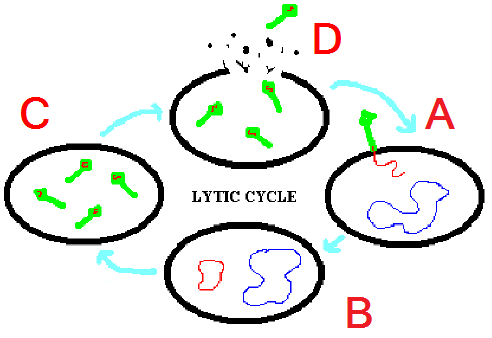Nutrition and Reproduction? How is that possible?
Because the Epstein-Barr virus (like all viruses) is considered "psuedo-living," reproduction is one of the main controversies that go along with it. How does something that is considered to be nothing more than a modified protein reproduce?
The Epstein-Barr virus contains double-stranded DNA, which carries its genetic information. Because viruses lack the equipment necessary for protein reproduction, they must reproduce using a host cell. For the Epstein-Barr virus the host cell must be that of a human, and more specifically a lymphatic cell or an epithelial cell in the mouth. The diagram below helps explain the lifecycle the virus takes part in.
A: Once a virus finds a suitable host cell (as stated above) it moves along the surface in search of receptor proteins to attach itself to. Once the virus finds these proteins it attaches to the surface of the cell via glycoproteins on the surface of its envelope. After attachment is complete the virus can either inject (bacteriophage) or fuse with the cell membrane. The Epstein-Barr virus fuses with the host cell's membrane and enters the cell via endocytosis. Once inside, the outer membrane is broken down and the DNA from the virus is released into the cell. This also makes the cell a viable target for the immune system.
B: During the time after the genetic material is released into the host cell, the virus uses the cell's metabolic machinery (i.e. the nucleus, proteins, ribosomes, and enzymes) to replicate itself. One of the first items made by the host cell is a polypeptide that destroys the host cell's DNA.
C: After the destruction of the host cell's DNA, the virus begins to replicate components of itself numerous times. When there are many components the replication stops and the virus pieces self assemble into complete, mature viruses. Any given host cell can contain up to two hundred complete viruses after this phase is complete.
D: After the viruses have completed self assembly they escape the cell. This can be done one of two ways depending on the type of virus. For most viruses, the common method of dispersal from the cell comes from enzymes the viruses secrete. These enzymes weaken the cell membrane allowing water to fill the cell, which eventually lyses (hence the name lytic cycle). The viruses then leave the cell and infect other proper host cells. However, the Epstein-Barr virus uses a slightly different tactic. Instead of destroying the cell membrane, the Epstein-Barr virus simply fuses with the cell membrane and buds off (exocytosis) taking a small portion of the cell membrane with it. This also allows for the virus to use the cell membrane it took from the host cell as an envelope or outer membrane. This membrane taken from the cell also contains the glycoproteins needed for the virus to attach to other host cells.
Characteristic of the Epstein-Barr virus and its relatives is a period of time known as the latent phase. During this time the viral genome remains in the nuclei of the cells, but only expresses a few genes and does not replicate. The latent phase of this virus can last for years or the entire lifetime of the infected individual. However, the latent phase of the virus comes after the active phase, and goes unnoticed by the infected person.
Does it eat?
While viruses can reproduce and are currently debated to be living organisms, there is not much to nutrition for them. As of now, viruses are modified proteins that are only capable of reproducing more of themselves. When existing without a host cell they are dormant and do very little on their own. Because viruses lack equipment for even basic metabolism, they also lack the need for nutrition.
Click here to learn more about these "relatives" of the Epstein-Barr virus!
